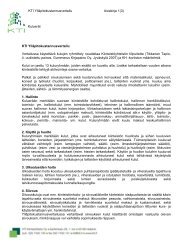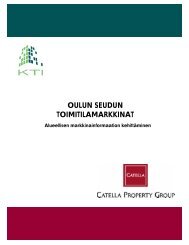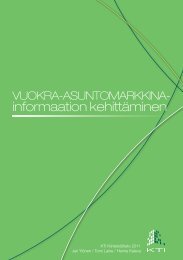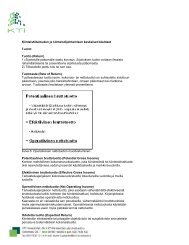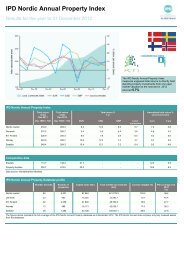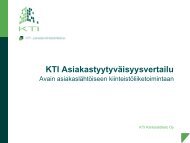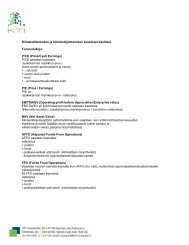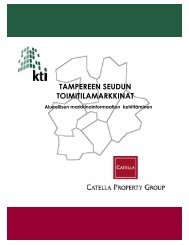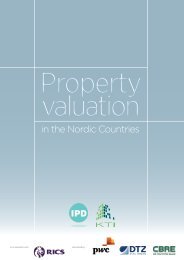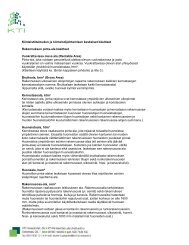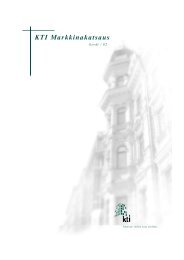The Finnish Property Market 2012 - KTI
The Finnish Property Market 2012 - KTI
The Finnish Property Market 2012 - KTI
Create successful ePaper yourself
Turn your PDF publications into a flip-book with our unique Google optimized e-Paper software.
In some cases, the rental agreement is for net rent, but the<br />
landlord takes care of the management and maintenance of<br />
the building, the costs of which are then recharged separately<br />
from the tenant. This kind of agreement is sometimes called<br />
a “shared rent”. This kind of agreements are becoming more<br />
popular as the basic form of “green leases”, as they attempt to<br />
share the benefits and risks of, among other things, energy<br />
cost fairly between the tenant and the landlord, as well as<br />
to motivate both parties towards energy savings. Otherwise,<br />
“green” terms of rental contracts are being developed actively<br />
currently, but not very widely applied yet.<br />
Rents can be indexed freely in all indefinite leases and in<br />
fixed period leases where the term exceeds three years. <strong>The</strong><br />
Consumer Price Index is the most commonly used index.<br />
“Green leases are not<br />
widely applied yet”<br />
Turnover-based rents are becoming more common in<br />
shopping centres, and they usually consist of a minimum<br />
base rent supplemented by an agreed share of turnover.<br />
However, the turnover-based part of the rent is typically<br />
quite low, as the landlord wants to secure a stable base for<br />
their cash-flow.<br />
In market downturns and over-supply situations, various<br />
means to attract tenants can be applied. This has been clearly<br />
seen, for instance, in the Helsinki metropolitan area office<br />
markets in recent years. Besides a decrease in rent levels, the<br />
use of rent-free periods, stepped rent increases and tenant<br />
improvements, among other things, are applied.<br />
plans. Detailed local plans are used to regulate the building<br />
and formation of the physical townscape. In addition, every<br />
local authority has its own building ordinance, the content of<br />
which is defined according to local needs.<br />
In the current act, local authorities have extensive powers<br />
to make independent decisions in land-use planning matters.<br />
It is also possible to agree on joint master plans between<br />
municipalities forming a homogenous urban area. <strong>The</strong>se<br />
joint master plans require the approval of the Ministry of<br />
the Environment. Together with the increased co-operation<br />
and integration of the municipalities, these kinds of plans are<br />
becoming more common.<br />
<strong>The</strong> Land Use and Building Act oblige municipalities<br />
to adopt an open and interactive approach to planning. <strong>The</strong><br />
local planning process is aimed at facilitating the involvement<br />
of all those concerned in planning: landowners, residents and<br />
businesses in the area.<br />
Building permits are approved by municipalities. A<br />
building permit may be granted if the plan allows the type<br />
and size of building that is being applied for. Special permits<br />
to exceed or change the use of the planned space can also be<br />
granted, although these are becoming increasingly difficult<br />
to obtain.<br />
Planning and building permit practices have recently<br />
been discussed actively, and they have been criticised<br />
for their lack of holistic approach to sustainability and<br />
urban structure issues, among other things. Municipalities<br />
compete with each other by using planning and land-use<br />
issues to attract taxpayers – both companies and residents –<br />
and employers, which can sometimes impact their planning<br />
decisions.<br />
18<br />
<strong>The</strong> <strong>Finnish</strong> <strong>Property</strong> <strong>Market</strong> <strong>2012</strong><br />
3.3 Planning<br />
Land use in Finland is regulated by the Land Use and Building<br />
Act. <strong>The</strong> system has three levels of land-use plans, including<br />
a regional land-use plan, local master plan and detailed<br />
local plans. Regulations and guidelines that complement the<br />
legislation in the Land Use and Building Act are included in<br />
<strong>The</strong> National Building Code. More detailed regulations and<br />
controls on land use and construction are included in the<br />
Land Use and Building Decree.<br />
National principles for land-use and regional structure<br />
are defined by the Council of State. <strong>The</strong>se national principles<br />
of land use are reflected in the regional plans, which embrace<br />
structural, functional and environmental considerations.<br />
Regional plans are drawn up and approved by Regional<br />
Councils, and confirmed by the Ministry of the Environment.<br />
<strong>The</strong> local master plan is an instrument for guiding and coordinating<br />
land use at a general level. It is produced by local<br />
authorities, but needs to follow the guidelines of the regional<br />
“New legislation<br />
controls the location of<br />
large retail units”<br />
Photo: Skanska / Pauliina Munukka




